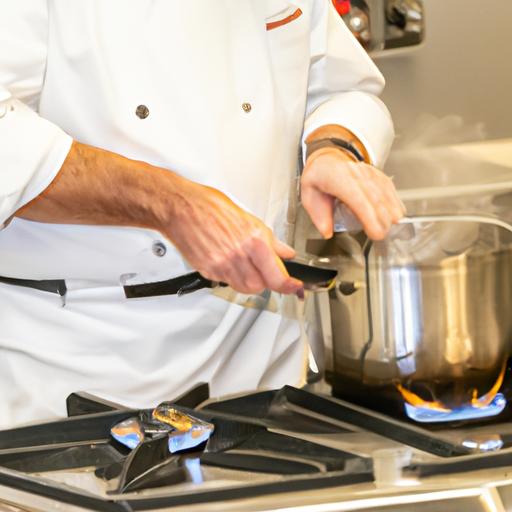Can Cooking Kill Botulism: Understanding the Risks and Prevention
Introduction
Did you know that lurking in your kitchen is a potential silent killer? It’s called botulism, a rare but serious illness caused by a toxin produced by the bacterium Clostridium botulinum. Botulism can be life-threatening, making it crucial for us to understand its risks and how to prevent it while cooking. So, let’s dive into the world of botulism and explore if cooking can truly kill this deadly foe.
Botulism is primarily caused by consuming food contaminated with the botulinum toxin. This toxin is usually found in improperly canned or preserved food, as well as in certain environmental conditions. It’s important to note that botulism can’t be detected by sight, smell, or taste, making it all the more dangerous.
What is Botulism?
Botulism is a severe illness that affects the nervous system, leading to paralysis and potentially fatal complications. It is important to understand the causes and sources of botulism contamination to effectively prevent its occurrence. Improperly canned foods, especially those with low acidity, provide an ideal environment for Clostridium botulinum to grow and produce the toxin. Additionally, honey and certain agricultural products can carry the spores of this bacterium.
The risks associated with botulism are not to be taken lightly. The toxin affects the nerves responsible for muscle control, resulting in symptoms such as blurred vision, difficulty swallowing, muscle weakness, and even respiratory failure. Prompt medical attention is crucial to prevent complications and save lives.
Now that we have a basic understanding of botulism, let’s explore the measures we can take to prevent this dangerous toxin from infiltrating our meals. Remember, prevention is always better than cure when it comes to botulism!
Stay tuned for Section II where we will delve deeper into the intricacies of botulism and its toxin.
What is Botulism?
Definition and Explanation of Botulism
Let’s start by understanding what botulism actually is. Botulism is a rare but serious illness caused by the bacterium Clostridium botulinum. This bacterium produces a toxin called botulinum toxin, which is one of the most potent toxins known to humans. When ingested, this toxin attacks the nervous system, leading to paralysis and potentially fatal complications.
Causes and Sources of Botulism Contamination
Now that we know what botulism is, let’s explore the causes and sources of its contamination. Improperly canned or preserved food is a common culprit. When food is not processed correctly, the botulinum spores present in the environment can survive and produce the toxin within the sealed container. Low-acid foods, such as vegetables, meat, and fish, are particularly susceptible to botulism contamination if not properly handled.
Aside from canned foods, honey can also harbor botulinum spores, posing a risk to infants under the age of one. Additionally, certain agricultural products, such as home-canned garlic and oil mixtures, can create an anaerobic environment that promotes the growth of Clostridium botulinum.
Risks Associated with Botulism
The risks associated with botulism should not be underestimated. The toxin affects the nervous system, leading to symptoms such as blurred vision, difficulty swallowing, muscle weakness, and even respiratory failure. Infants, elderly individuals, and those with compromised immune systems are particularly vulnerable to severe complications if infected with botulinum toxin.
It is important to note that botulism is a rare illness, but its potential consequences make it vital for us to be aware and take preventive measures. In the next section, we will explore prevention and control measures that can help us keep botulism at bay.
Stay tuned for Section III, where we will dive deeper into the intricacies of botulism toxin and its effects on the body.
Understanding Botulism Toxin
Botulism toxin, produced by the bacterium Clostridium botulinum, is a potent neurotoxin that can have severe effects on the human body. Let’s dive into the details of this toxin to better comprehend its impact.
Overview of Botulinum Toxin and Its Effects
Botulinum toxin is one of the most powerful toxins known to mankind. It works by blocking nerve signals, leading to muscle paralysis. This paralysis can affect various parts of the body, including the face, limbs, and respiratory muscles. The toxin’s potency is so significant that it only takes a small amount to cause serious harm.
How Botulism Toxin is Produced
Clostridium botulinum, commonly found in soil, produces the botulinum toxin under specific conditions. These conditions include low-oxygen environments and certain pH levels. When food is improperly canned or preserved, without sufficient heat or pressure to kill the bacteria or spores, the dormant spores can germinate and produce the toxin. This is why proper canning techniques and storage are crucial to prevent botulinum toxin formation.
Symptoms and Dangers of Botulism Toxin Exposure
Exposure to botulinum toxin can lead to a range of symptoms that typically appear within 12 to 36 hours after ingestion. These symptoms may include blurred vision, drooping eyelids, difficulty speaking and swallowing, muscle weakness, and respiratory issues. If left untreated, botulism can progress to more severe complications, such as respiratory failure and even death.
It’s important to note that botulism toxin is heat-labile, meaning it can be destroyed by high temperatures. However, the spores that produce the toxin are more resilient. We’ll explore the effectiveness of cooking in killing botulism and preventing its risks in the upcoming sections.
Stay tuned for Section IV, where we will discuss prevention and control measures to keep botulism at bay in our kitchens.
Prevention and Control Measures
A. Safe Food Handling Practices to Prevent Botulism Contamination
When it comes to preventing botulism, proper food handling practices are essential. Start by ensuring that all perishable foods are stored appropriately at the right temperature. Refrigerate or freeze foods promptly to inhibit the growth of Clostridium botulinum and reduce the risk of toxin production.
Additionally, always practice good hygiene while handling food. Wash your hands thoroughly with soap and water before and after handling any raw or cooked food. Clean and sanitize all utensils, cutting boards, and surfaces that come into contact with food to prevent cross-contamination.
B. Importance of Proper Canning Techniques to Avoid Botulism
Canning is a popular method for preserving food, but it can become a breeding ground for botulinum toxin if not done correctly. Ensuring proper canning techniques is crucial in preventing botulism contamination. High-acid foods, such as fruits and pickles, can be safely preserved using a water bath canner. However, low-acid foods, including vegetables, meats, and seafood, require pressure canning to destroy any potential botulism spores.
It’s essential to follow approved canning recipes and processing times provided by reliable sources, such as the National Center for Home Food Preservation. These guidelines have been developed based on scientific research to ensure the safety of canned foods.
C. Guidelines for Storing and Handling Canned Foods
Even if you’ve canned your food properly, it’s important to handle and store the canned goods correctly to maintain their safety. Inspect the jars for any signs of spoilage, such as bulging lids or strange odors, before consuming the contents. If any doubt arises, it’s better to be safe than sorry – discard the contents immediately.
Store canned foods in a cool, dry place away from direct sunlight. Extreme temperatures can compromise the quality and safety of the canned goods. Remember to rotate your stock, using the “first in, first out” principle, to ensure that older cans are used before newer ones.
D. Ensuring Proper Cooking Temperatures to Kill Botulism Spores
Cooking is a powerful weapon against botulism, as it has the potential to kill the botulism spores and render them harmless. To eliminate the risk of botulism, ensure that food is cooked at the appropriate temperatures. The USDA recommends cooking most foods to an internal temperature of 165°F (74°C) to ensure thorough cooking and kill any potential botulism spores.
However, it’s important to note that not all cooking methods are equally effective in eliminating botulism spores. For example, boiling for 10 minutes can destroy the toxin, but it may not be sufficient to kill the spores. Pressure cooking is highly effective in destroying botulism spores, making it an excellent choice for canning low-acid foods.
By following these prevention and control measures, you can significantly reduce the risk of botulism contamination in your kitchen. Stay tuned for Section V, where we will explore the question of whether cooking can truly kill botulism.
Can Cooking Kill Botulism?
Exploring the Heat Resistance of Botulism Spores
When it comes to the question of whether cooking can eliminate botulism, we must first understand the heat resistance of botulism spores. Botulism spores are incredibly resilient and can survive in various conditions, including high temperatures. These spores have the unique ability to withstand boiling water, making it essential to take additional precautions in the kitchen.
Understanding the Importance of Adequate Cooking Temperatures
While cooking is an effective method to kill many harmful bacteria and pathogens, it’s crucial to ensure that food reaches adequate cooking temperatures to destroy botulism spores. The recommended internal cooking temperature varies depending on the type of food being prepared. For instance, meats should be cooked to an internal temperature of 145°F (63°C) for medium-rare and 165°F (74°C) for poultry. By reaching these temperatures, you can significantly reduce the risk of botulism contamination.
Factors That Affect the Ability of Cooking to Kill Botulism
Several factors can impact the ability of cooking to eliminate botulism. One crucial factor is the initial contamination level. If the food contains a high concentration of botulinum toxin or spores, even cooking at high temperatures may not completely eradicate the bacteria. Additionally, the duration of cooking plays a role. Extended cooking times can help ensure that the internal temperature of the food remains consistent and reaches the necessary threshold to kill off any potential botulism spores.
Safe Cooking Practices to Eliminate Botulism Risk
To minimize the risk of botulism, it is essential to follow safe cooking practices. Here are a few tips to keep in mind:
- Use a reliable food thermometer to ensure food reaches the recommended internal temperature.
- Avoid consuming home-canned or preserved foods if you are unsure about their safety.
- When canning foods at home, follow proper canning techniques, including using adequate pressure and temperature to kill botulism spores.
- Store canned foods in a cool, dry place and discard any cans that appear damaged or bulging.
- Always practice good hygiene, wash your hands thoroughly, and sanitize cooking utensils and surfaces to avoid cross-contamination.
While cooking can significantly reduce the risk of botulism, it is crucial to understand that it may not completely eliminate all traces of the bacteria. By following these safe cooking practices, you can greatly reduce the likelihood of encountering botulism and protect the health of yourself and your loved ones.
Stay tuned for the conclusion where we will recap the key points discussed and emphasize the importance of following safe cooking practices to prevent botulism.
Conclusion
In conclusion, understanding the risks of botulism and taking preventive measures is essential for safe cooking practices. Botulism, a rare but potentially deadly illness caused by the botulinum toxin, can be prevented by following proper food handling and cooking techniques.
By adhering to safe food handling practices, such as storing canned goods properly and using correct canning techniques, we can minimize the risk of botulism contamination. It is important to be aware of the heat resistance of botulism spores and ensure that our cooking reaches the necessary temperatures to kill them.
Remember, cooking alone may not always be sufficient to eliminate botulism. Factors such as the type of food, cooking method, and the presence of other contaminants can affect the effectiveness of cooking in killing botulism. Therefore, it is crucial to exercise caution and follow recommended guidelines to reduce the risk.
By staying informed and taking the necessary precautions, we can protect ourselves and our loved ones from the dangers of botulism. So, the next time you step into the kitchen, remember the importance of proper food handling, canning techniques, and cooking temperatures in keeping botulism at bay.
Stay safe, stay informed, and happy cooking!
Note: This article is for informational purposes only and should not be considered a substitute for professional medical advice. If you suspect botulism or experience any symptoms, please seek medical attention immediately.





